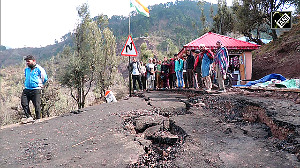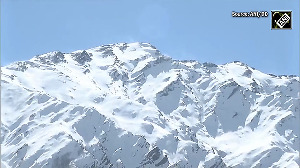It's no small irony that curfew had to be re-imposed in parts of the Kashmir valley the very day the state announced a settlement with the Sri Amarnath Yatra Sangharsh Samiti, which ended the two-and-a-half months-long militant agitation in the Jammu region. The settlement evoked an apathetic or an adverse response in the valley. The Kashmir Coordination Committee, comprised of the All Parties Hurriyat Conference, and motley groups of traders and professionals, said it fails to address the real issue, azadi, and called a general strike. The People's Democratic Party called it 'unilateralist' and 'authoritarian'.
Yet, even the hurriedly reached Jammu settlement may prove a poor consolation prize. Had its negotiation taken on board the valley's politicians, it would have had a more democratic character and wider acceptance. After all, the political and physical origins of the problem that triggered the twin agitations in Jammu and the valley, and led to the unseating of J&K's government in July, lie in the transfer of valley land for the Amarnath shrine pilgrimage.
In Jammu, a tangled tale is written in blood
The settlement is flawed. It reserves 100 acres of state land exclusively for the Shri Amarnath Shrine Board's use, thus barring sheep-grazers and other traditional users. It doesn't mention the land's return. And it compensates the Jammu residents for the economic losses caused by the agitation, but is silent on compensating the valley people who suffered from seven weeks of a blockade which cut off essential supplies and despatch of perishable fruit.
Had the valley's representatives been involved in negotiating a fair agreement, they wouldn't have had the luxury of putting the onus for it solely on the state or central government. The accusation that the government acted without consulting all sides to the land dispute is potentially open to exploitation to rank communal or narrow regionalist ends. But evidently, our policymakers have learnt very little from Kashmir's recent history, which shows that such potential will nearly always be so exploited.
The valley continues to seethe with anger. The turmoil shows no signs of abating despite the onset of the holy month of Ramzan. The unrest could yet again become a serious problem for India, with unpleasant implications for its fraught relations with Pakistan.
In Jammu, the SAYSS has threatened to take up the issue of the region's allegedly weak representation in power structures and to fight for "justice". The settlement has not neutralised the political agenda of the Jammu agitators, many of them closely allied to the Bharatiya Janata Party. This agenda favours the state's polarisation along regional and religious-communal lines -- and eventually, its trifurcation into a predominantly Hindu Jammu region, a Muslim-majority Kashmir valley, and a primarily Buddhist Ladakh.
Multiple blunders have brought J&K to this pass after six years of relative peace under an elected Congress-PDP coalition. After consciously encouraging the yatra, which led to a 25-fold increase in the number of pilgrims over 20 years, the government extended its duration to eight weeks -- although the ice lingam survives for only two weeks. All this was seen in the Valley as promoting aggressive Hindutva nationalism to counter Kashmiri separatism.
Then, in an ill-advised move, largely to placate Hindu-communal sentiment, the government illegally transferred forest land to the SASB. It failed to anticipate the Islamic-separatist reaction, and an even more militant counter-reaction in Jammu to the transfer's cancellation, leading to a violent blockade along the Jammu-Srinagar highway. It refused to lift the blockade until the entire pear crop in the valley had perished.
Lalit Koul: Appeasement is never good for a nation
Meanwhile, the Jammu protests took on an explicitly political and communal character as the BJP fished in the troubled waters with an eye on the assembly elections. Its rough acid-throwing methods drew an adverse reaction from the rest of India, which is one reason why it withdrew the agitation with relative ease. But the Congress didn't play much better. Its Jammu leaders were partisan towards the communal forces and openly joined the agitation.
The display of trishuls and swords by the Jammu agitators along with the national flag, their open espousal of Hindutva, and their demonisation of all Kashmiri Muslims as 'anti-national' only added to the ferocity of the protests in the valley, and put separatists in their forefront.
In the second week of August, the J&K administration cracked down heavily on the valley, entering people's homes, and arresting hundreds without reason. On August 11, it allowed a several lakh-strong procession to form on the Srinagar-Muzaffarabad highway, and then opened fire on it. Many Kashmiris say the government handled the Jammu agitation with kid gloves, but used brute force in the valley against peaceful protests: 'rubber bullets in Jammu, but live bullets in the valley'. By then, some 40 people had died in the valley.
Amarnath fallout may engulf India
This only heightened the alienation of the valley's people from the Indian state and strengthened the separatists, bringing extremists like Syed Ali Shah Geelani out of the woodwork. It's as if Indian policymakers had deluded themselves that popular alienation had disappeared in the last few years with the return of relative normality: The Kashmir economy improved. Tourism boomed. The extremists were isolated. Issues of day-to-day governance became dominant. Why, even the Hurriyat was on the verge of deciding not to issue a call to boycott the assembly elections, as it usually does!
Better sense prevailed around August 15-18, when the government allowed peaceful protests, which are always spirited on India's Independence Day. Governor N N Vohra was determined that there should be no more firing. This had a salutary effect and encouraged the Hurriyat's moderate faction to adopt sober positions.
Soon, however, National Security Adviser M K Narayanan intervened. He visited the valley on August 20 along with the Intelligence Bureau chief and other hardline officials and criticised Governor Vohra for his 'softline' on the Islamic-extremists. Thus began the massive crackdown of August 24-25, when nine valley districts were handed over to the army, newspapers banned, TV channels shut down, and mobile-telephone SMS services disabled.
This cost the Indian state a massive loss of legitimacy. Yet, says Yusuf Tarigami, a Communist Party of India-Marxist MLA, and a widely respected J&K leader: "Mercifully, popular alienation is not as severe as in the early 1990s, and may yet prove transient."
There are a number of differences between the post-1989 climate and the present situation. Then, a variety of armed groups, including the indigenous Hizbul Mujaheedin, were hyperactive in demanding Kashmir's separation from India. They subdued the relatively moderate Hurriyat leadership. Pakistan armed and financed them, and lent them logistical support. The savage repression unleashed by Indian forces helped them build a support base.
Today, militant groups can no longer recruit in the valley. Until recently, extremists had become irrelevant. Kashmir hasn't been a live political issue in Pakistan since the peace process with India started. It still isn't. The most noticeable difference from the past is the bitterness and anger among the youth, who grew up in a climate of violence, humiliation and hatred in the 1990s.
Yet, it isn't too late yet to rescue the situation. Contrary to what some critics argue, I take the view that the right to self-determination isn't an absolute right, and must be balanced by considerations of democracy, pluralism and the rights of 'minorities within the minorities'. It's also probably wrong to view the present, possibly transitory, popular mood in Kashmir as unqualified and categorical endorsement of azadi, especially azadi interpreted as considered support for a sovereign, independent state or for Kashmir's merger with Pakistan.
'Jammu is treated like a pariah, because we are patriots'
And yet, business-as-usual is not an option in J&K. Hardliners like Narayanan indulge in dangerous self-delusion when they declare, as he did on a television channel on August 30, that Kashmir will become normal "in 10 days' time", presumably without a pro-reconciliation initiative. It simply won't do to underestimate the seriousness of Kashmiri alienation and disgust with the overwhelming presence of Indian security forces in the valley.
The Indian state must radically rethink its Kashmir policy. It must reach out to the Kashmiri people with the offer of a dialogue in earnest and put the issue of autonomy up-front on the table. Such a dialogue must include even extremist pro-azadi leaders.
For a dialogue to succeed, four things are essential. First, an opening of the border with Pakistani Kashmir. This will not only facilitate trade and people-to-people exchanges, but also allow the valley Kashmiris to critically evaluate the quality of life and politics in 'Azad Kashmir'. Second, genuine implementation and strengthening the special status for Kashmir under Article 370 of the Constitution, which has been greatly diluted.
B S Raghavan: Jammu is not for burning
Third, discussion of the regional and interregional autonomy proposals made 10 years ago by the Balraj Puri committee, recommending devolution of power to local/regional bodies. And finally, a thinning out of the presence of Indian security forces in the valley. The Indian state must gather the courage to take these steps as necessary preconditions to build confidence among the Kashmiris. Or, the Kashmir problem could soon become intractable.






 © 2025
© 2025